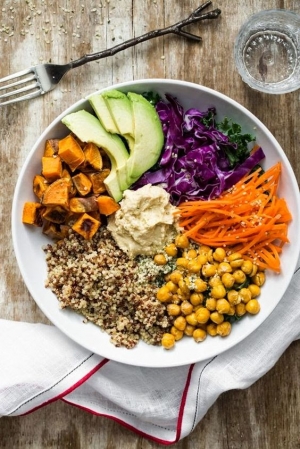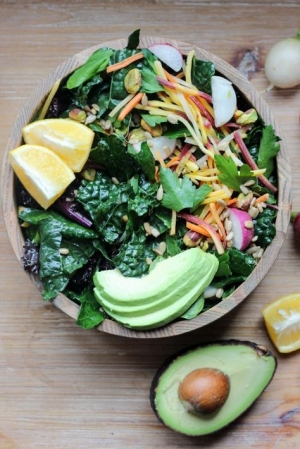
Displaying items by tag: vegetables
Starting a Food Garden: How Growing Your Own Vegetables Can Ease Food Supply Anxiety & Support Health
It makes sense. As many of us spend more time at home, some of us staring at lawns whose only nutritional value is in the odd dandelion, and some of us just wanting to be more self-reliant, more and more people are feeling the urge to grow something edible. And it’s true that growing food can make us more self-sufficient and give us a feeling of control in a world in which so much is out of our control.
But growing food also gives us this triple whammy:
- People who grow more vegetables tend to eat more vegetables;
- People who eat more vegetables tend to be healthier; and
- Healthy people are far less likely to get seriously sick with COVID-19.
The truth is, growing nutrient-rich fruits and vegetables is one of the best health insurance policies you can take out.
Turning Lawns into Food Gardens
As a society, it’s not like we don’t have the land. Lawns are the single largest irrigated crop in the US, covering nearly 32 million acres. On the other hand, fruits and vegetables grow on only about 10 million acres in the United States. This means the space that American lawns occupy could provide enough land to literally quadruple the amount of fruits and vegetables grown in the country!
Home gardening is a rapidly growing movement. Heirloom seed companies like Johnny’s Selected Seeds and Southern Exposure Seed Exchange are already overwhelmed with orders and have resorted to rationing on their websites. Nurseries and garden centers nationwide report booming sales of vegetable and herb seeds and plants. And Google Keyword Trends shows the newfound popularity for searches such as “growing food,” “vegetable gardens,” and “victory gardens.”
Wait, “victory garden”? What the heck is that?
The Origins of the “Victory Garden” Movement
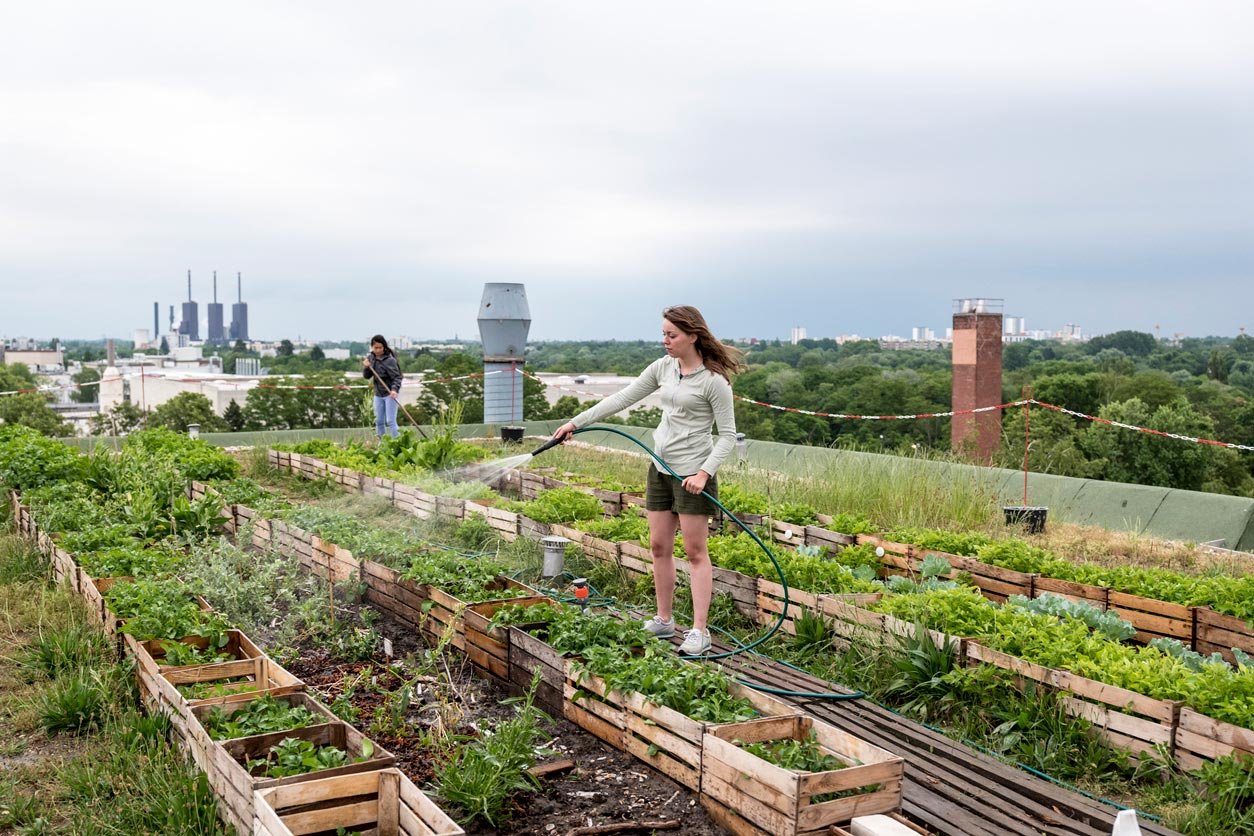
The first Victory Garden movement began during World War I. With millions of Americans fighting overseas, the US government diverted commercial crops to the European theater and redirected transportation towards moving troops and munitions instead of food. Ordinary citizens stepped into the breach and started a food garden wherever they could: rooftops, fire escapes, empty lots, schools, and backyards. The efforts of ordinary “stay-at-home” Americans saved entire European populations from starvation and disease.
These “war gardens” or “victory gardens” persisted following the war’s end during the social distancing that accompanied the global 1918 Spanish Flu pandemic. Americans, Canadians, British, and Australians kept their gardens growing right through the Great Depression and World War II. At one point, 20 million backyard, school, and community victory gardens provided more than 40% of the vegetables eaten in the United States.
The World War II revival of victory gardens, while expressing solidarity, sacrifice, and patriotism, was tinged with an overlay of racism as Americans gardened to replace the lost labor of the many Japanese farm workers who were forced into internment camps. But let’s remember that at its roots, and for decades of hardship, the concept of a victory garden was birthed to help feed a nation and then help it survive a pandemic.
The Current Threats to Our Food Supply
Many people are experiencing disruptions in our food supply chain now, seeing empty grocery store shelves, waiting in long lines to buy staples, and hearing daily stories of food hoarding. Those of us used to next-day Amazon delivery are now waiting weeks or even months for food deliveries — if they ever come. Food banks and pantries for the poor are experiencing long lines, and in some cases, have had to resort to rationing. So what’s causing these problems?
For one thing, a large segment of the food industry caters to institutions that have largely shut down for the time being: restaurants, schools, hotels and conference centers, stadiums, theme parks, airports, and cruise ships. Manufacturers can’t just repackage industrial-sized bags of rice and flour into consumer sizes overnight. And tragic amounts of fresh produce are rotting in fields and orchards because the system isn’t set up to transport fruits and vegetables to hungry consumers. Meat and dairy are particularly affected, partly because it’s harder to transport animal-based foods safely and partly because the slaughterhouses, dairies, and processing plants are, themselves, hotbeds of COVID-19. (Editorial aside: Now could be a great time to go plant-based, if you haven’t already made the leap.)
Border closures, grounded airlines, closed ports, and restrictions on movement have also made it harder to continue food production and transport goods internationally. And since much of the food sold in the US today originates from overseas, supply chain breakdowns create the potential for shortages of critical ingredients or components.
Political issues are exacerbating the crisis, too. As more front-line workers in the fast food and grocery industries are hospitalized with or die of the virus, others are going on strike and engaging in protests against the apparent disregard for human life shown by the policies of Walmart, Amazon, and other large retailers that remain in operation.
Given all these present threats, which have arisen on top of a food system that was already fragile due to unsustainable farming practices and rampant inequities (food service and agricultural workers weren’t exactly being treated like royalty, to begin with), it’s no wonder home gardening is making more and more sense.
10 Reasons to Start a Food Garden Today
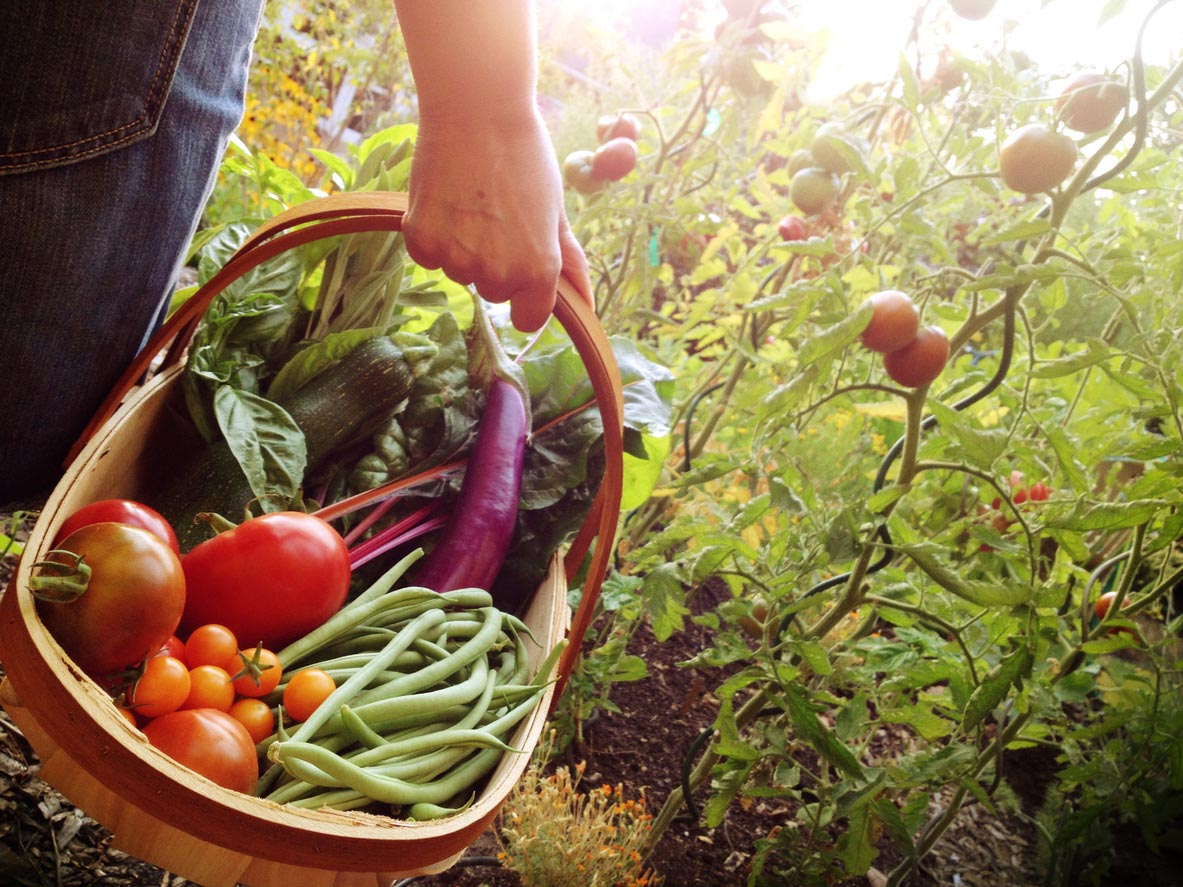
Even if you aren’t struggling to get enough food to feed your family, there are still a bunch of good reasons to start a food garden.
1. Self-reliance
The industrial agriculture system that provides most of our food is inherently unstable. In a few generations, we’ve depleted some of the richest topsoil deposits in the world. And we’ve resorted to using synthetic fertilizers and increasingly toxic pesticides and herbicides to maintain productivity. There’s no way this industrialized and chemical-dependent method of farming can continue to feed us long-term. By starting to grow your own food, you begin to assert control over your family’s food supply.
2. Sense of Purpose
I’ve seen a lot of “humorous” memes to the effect that the most patriotic thing we can do these days is stay home and binge-watch Netflix. While it’s true that social distancing saves lives, there are many things we can do that can make the world a better place. For one, we can plant and tend a garden to feed ourselves. If you’re not in the long line outside the supermarket, then the line is that much shorter for everyone else. Today’s food garden takes some of the pressure off an already teetering food system. And if that’s not patriotic, I don’t know what is.
3. Learn a New Skill
Gardening is a skill set — one that’s fun to learn and invaluable once you’ve gotten the hang of it. And I would argue that the ability to grow your own food is as fundamental to survival and well-being as reading, writing, and computer literacy.
4. Cleaner, Safer Food
Unless you’re buying only locally-grown, organic fruits and veggies, the produce that you get from the supermarket is often laden with pesticides, herbicides, and protective wax coverings. When you grow your own, you’re in charge of quality control. Growing a small food garden allows you to pick pests off by hand or use non-toxic pest management options. Therefore, you don’t need to rely on toxic sprays and powders to keep critters off your cauliflower. And since most “fresh” produce that you can find in the supermarket was harvested a week or two before you can buy it, the food that you grow yourself will be much fresher, with a higher nutrient profile.
5. Get More Fruits and Veggies in Your Diet
I’ve never seen a seed catalog selling Pop-Tart bushes and Snickers trees. Your food garden will naturally contain the healthiest foods on the planet: fruits, veggies, legumes, and roots. And what you grow, you’ll eat. Even picky eaters won’t be able to resist a ripe heirloom tomato or just-picked kale and cucumber salad that they harvested themselves.
About that delicious, funny-looking heirloom tomato: You will have a hard time finding that variety in your big supermarket. Most produce varieties aren’t bred for taste or nutrition. Instead, they were developed to withstand transcontinental shipping in 18-wheel freightliners. When you start a food garden, you have the opportunity to buy varieties that taste much better and are far more nutritious than the standard ones you’re used to. The only downside is that you have to eat them within a day or two of picking, which is not really a downside at all!
Global Public Service Announcement: If you’re doing OK financially, and looking for a worthwhile project to support, check out veganic gardener Will Bonsall’s Scatterseed Project. Will has been saving rare and heirloom seeds for over 40 years. And his collection contains the only known examples of certain varieties that may thrive under the pressure of climate change. As Will says, “Genetic diversity is the hedge between us and global famine.” The documentary Seed: The Untold Story features his work. Watch this segment of the film, and consider supporting Scatterseed to ensure that these infinitely valuable seeds survive.
6. Reduce Your Risk of Chronic Disease
The science is abundantly clear that the more whole plant foods you consume, the lower your risk of developing cardiovascular disease, high blood pressure, obesity, and type 2 diabetes. This is a compelling reason to add more fruits and veggies to your diet at any time. But it’s even more urgent an argument during the coronavirus pandemic. Studies out of New York are showing the link between chronic disease and COVID-19 mortality. Eighty-nine percent of those who died from the virus had pre-existing chronic conditions. And obese people were twice as likely to die as those of normal weight. This is the perfect time to clean up your diet, reducing your intake of processed and animal-based foods, and upping your consumption of life-giving plants.
7. Reduce Your Grocery Bill
Like any new hobby, you can start gardening frugally, or you can buy every labor-saving device on the market. If you begin with just a few packets of seeds and a couple of bags of potting soil, you’ll recoup your investment through a reduced grocery bill within a few months. If you’re converting a lawn into a garden, you may not even need new soil. And if you haven’t been spraying herbicides on your grass, you may have nutrient-rich soil ready for your first round of crops without adding any amendments. An added bonus is if you can compost your kitchen scraps, saving money on fertilizer by creating a nutrient cycle from garden to kitchen, back to garden.
8. Avoid Virus-Contaminated Food
Many of us pick up a piece of fruit at the supermarket, feel it for freshness, and then put it back down if we aren’t satisfied. If you assume that we haven’t broken that habit completely, then it’s likely that some of the produce on our supermarket shelves could already be contaminated with SARS-CoV-2, and possibly other pathogens as well. Sure, you can take it home and wash it well, but think of all the surfaces it can touch, as well as where your hands will go before you can disinfect everything. The produce you grow in your garden will contain only the pathogens that you bring to them.
9. Get Outside
If you have a piece of land — even a small yard — then gardening gives you a reason to spend time outside. Even as we try to stay safe through social distancing, we also need sunshine, exercise, and fresh air to be well, physically and mentally. There are also significant health benefits to being in contact with soil. Getting dirty supports our immune system, and many of the compounds in soil can improve our mood and cognitive functioning. Some researchers have gone so far as to call the soil microbiome a “human antidepressant.”
10. Grow It Forward
In addition to growing a bounty of beautiful vegetables for yourself, consider sowing a few extra seeds to support your local food shelf. Plant a Row for the Hungry (PAR) is sponsored by GardenComm to help connect local growers with agencies that serve the food insecure. No PAR committee in your community? No problem. Grow those plants, and then reach out to your local food pantry or soup kitchen to make plans to share from your harvest. If you grow an overabundance of anything, there’s no need for it to go to waste (or turn into compost) when it could feed hungry people instead.
How to Start Your Food Garden
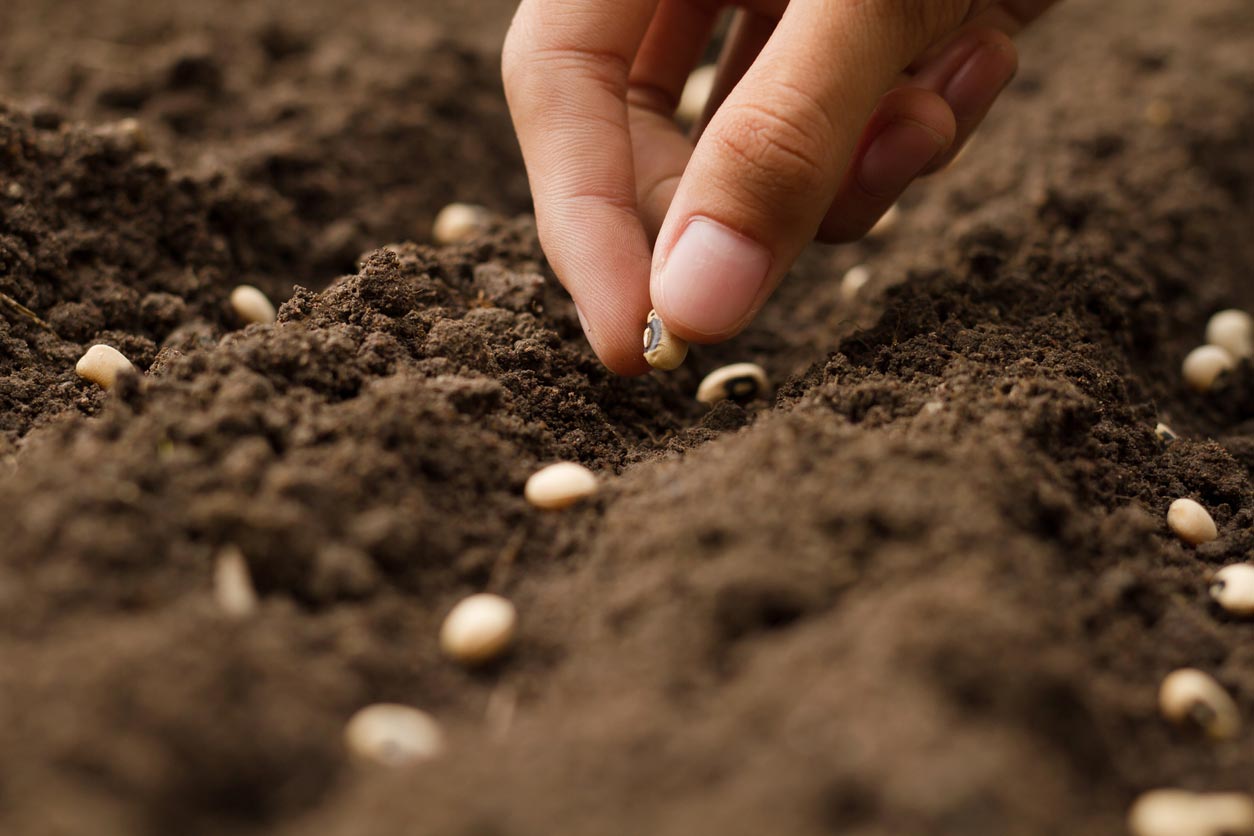
If you’ve never gardened before, the most important thing is to avoid overwhelm. There are many guides out there to help you get started with minimal investment, effort, and confusion.
1. Use a Planting Calendar
First, check a planting calendar for information on what grows where you live. The United States Department of Agriculture has a Hardiness Zone Map that will tell you what “zone” you live in. The zones differ by first and last frost date, average high and low temperatures, and hours of sunlight, among other criteria. Once you know your zone, you can check seed packets for information about when to plant and harvest in that zone. You can also Google “[Your state or city] planting guide” or planting schedule. You’ll find excellent information from seed companies, local agriculture extension offices, and universities that will tell you what grows well in your region and how to plant, nourish, and harvest those crops.
2. Do Your Research
Next, read up on edible gardening for rural, suburban, or urban environments (depending on where you are). Some good books include The Urban Micro-Farm, Edible Landscaping with a Permaculture Twist, and Edible Landscaping.
Once you’ve done a bit of research, talk with your family members about what foods they’d like to grow and eat. You’ll get a lot more help and enthusiasm when you gear the garden to their goals and desires. Once you’ve got a plan, it’s time to decide how you’re going to garden prior to ordering seeds or seedlings, gardening supplies, and potting soil.
3. Prepare Your Garden
The most straightforward method is to remove grass with a hoe, rototiller, or (for much bigger areas) a small tractor. And then, work the underlying soil for tilth and nutrients, and start planting directly into the ground. You might also want to conduct a couple of simple soil tests for pH and nutrient content. Gardening stores sell test kits for a few dollars. And local agriculture extensions and county agencies often allow local farmers and gardeners to bring in soil samples for free testing (Although check with them first since social distancing may have shut down this service in your area). Once you’ve tested, you can determine what (if anything) you might need to add to your soil and what plants are most likely to thrive in your conditions
Container Gardening
If you don’t have a yard suitable for cultivation, the easiest way to get started is with containers. You can use pretty much anything: large flower pots, milk crates lined with burlap, wicker baskets, and non-toxic grow bags can all serve. You’ll need drainage, so you’ll have to poke or drill holes in the buckets and plastic containers.
Containers are actually ideal in that you have total control over the soil. And you can position them for maximum sun and protection from wind. If they’re small enough, you can even move them around. Plants that thrive in containers include tomatoes, herbs, salad greens, beans, broccoli, peppers, cucumbers, and dark leafy greens.
If you have no outdoor space, you can garden indoors with containers. All you need is a decent light source. Garden centers will sell you specialized grow lights, often on timers, but they can be pricey. You might do almost as well with LED or fluorescent shop lights from a home improvement store. Wire shelving makes a great place to grow plants with the shop light attached to the shelf above. And if you have good outdoor lighting from windows, then you can let your plants photosynthesize the natural way — from the sun.
Straw Bale Gardening
If you have more space, but no good soil, consider straw bale gardening. You can turn a bale of straw (not hay, which contains seeds that will compete with your plantings) into a growth medium by watering the bale for 10 days or so, topping with potting soil and planting seeds right in the soil. As the straw breaks down, its nutrients become available for the growing plants.
The Sheet-Mulch Method
If you have a lawn that you’d like to convert quickly to vegetable production, consider the sheet-mulch method. This consists of putting down cardboard or some other organic material to block the growth of grass. And then, adding layers of mulch, compost, and topsoil on top of the former lawn. This works much better with established seedlings than sowing seeds directly into the mulch, so you’ll have to buy seedlings or start them indoors in trays.
Raised Bed Gardening
Another option is to create raised beds and fill them with high-quality growth medium. You can build the beds out of wood, or order raised bed kits online and put them together yourself. These tend to be more expensive since you’ll need to purchase enough soil and amendment to fill them to a depth of at least one to two feet, but you’ll be able to plant in them right away. Also, if your lawn contains pesticides, herbicides, and toxic building materials, raised beds can give your veggies a “fresh start” with clean, imported soil.
Greenhouses
If you’re fortunate enough to have space for a greenhouse, you can garden pretty much year-round. You can add weeks to the start of the growing season by starting seedlings in the greenhouse well before you can plant them outdoors. And you can grow fall crops like lettuce and kale in the greenhouse even in cold, snowy winters.
Whatever route you take, try to reach out to local gardeners, who will be able to balance your book knowledge with practical experience growing in your area. And don’t forget the University of YouTube as a great “how-to” resource for developing your green thumbs!
Thanks Ocean Robbins - The Food Revolution May 2020
The Silent Killer
The silent killer affecting more than 7 million Australians
How do you get people to care about a disease with no symptoms? That’s the challenge for doctors worried about non-alcoholic fatty liver disease which can lead to liver cancer and liver failure – often with little warning.
“By 2020 more people will have liver cirrhosis caused by non-alcoholic fatty liver disease than with hepatitis C and hepatitis B combined,” says Dr Alex Hodge of Melbourne’s Monash Medical Centre and University.
The Gastroenterological Society of Australia estimates that translates to more than 7 million Australians by 2030. About 5% will have developed cirrhosis.
“That’s 400,000 people with liver cirrhosis that could be avoided,” says Hodge.
Non-alcoholic fatty liver disease is an umbrella term for a range of liver conditions affecting people who drink little to no alcohol. As the name implies, the main characteristic of non-alcoholic fatty liver disease is too much fat stored in liver cells.
The condition is also closely linked to metabolic syndrome, which is a cluster of abnormalities including increased abdominal fat, poor ability to use the hormone insulin, high blood pressure and high blood levels of triglycerides, a type of fat.
Non-alcoholic fatty liver disease usually causes no signs and symptoms. When it does, they may include: Enlarged liver, fatigue and pain in the upper right abdomen.
Experts don’t know exactly why some people accumulate fat in the liver while others do not. Similarly, there is limited understanding of why some fatty livers develop inflammation that progresses to cirrhosis. However, experts do know the disease is linked to being overweight or obese, having insulin resistance, high blood sugar and a high level of fats in the blood.
They also have a threefold risk of type 2 diabetes and double the risk of heart disease.
Losing weight around the middle and eating healthier food is the only way to reverse or reduce it, Hodge says.
His research found evidence that fasting might improve fatty liver disease. A study of patients at Monash Medical Centre found that restricting eating (but not kilojoules) to just an eight-hour period between noon and 8pm improved markers of fatty liver disease and reduced abdominal fat.
Dr Sandra Cabot says other things you can do to help reverse a fatty liver include, avoiding sugar, increasing the amount of raw plant food in your diet, eating protein with every meal and avoiding huge meals.
Thanks MiNDFOOD for the article www.mindfood.com
The 5 components that make every meal gut-healing
By Robyn Youkilis 28 February 2018
I created my Good Gut Rule of Five to show you exactly what to put on your plate at lunch and dinner. Eating in this way will ensure that you are getting a balance of both macro- and micronutrients, as well as my favorite gut-healing superfoods (which I talk about more in my book, Thin From Within). Aim to include one ingredient from each of the five categories that follow for a complete and balanced meal:
1. Greens:
Kale, collards, arugula, spinach, lettuce...I love ’em all. Aim to have at least two or three big handfuls of greens with most meals. Greens do it all when it comes to gut health and weight loss: They are packed with fiber, which helps fill you up and keep you regular. Plus, leafy green veggies are some of the most nutrient-dense foods, and when you are filling your cells with nutrients (I mean real nutrition, not just calories!), you have more energy and fewer cravings.
2. Healthy fat:
Avocado, olive and flax oils, almonds, butter from grass-fed cows (so the cows have healthy guts too!), and coconut oil all count here. Add 1 to 2 tablespoons of oil, 1 to 2 ounces of nuts, or ¼ to ½ of an avocado at each meal for a good dose of flavor and satiation. Plus, fats are essential for proper absorption of most vitamins and minerals. I used to be terrified of fats, but now I include them at every meal and am lighter than I’ve ever been.
3. Protein:
Wild salmon, grass-fed beef, organic chicken, tempeh, sprouted lentils, and canned wild sardines are some examples of great go-to protein options. Protein keeps you full and stabilizes your blood sugar, so you won’t keep dipping into your raw chocolate stash or crash halfway through your afternoon meetings.
4. Fermented food:
Including fermented foods on your plate is the good-gut secret to weight loss through a healthy microbiome (you need all that great bacteria throughout the day to keep your digestion humming!). Examples include raw sauerkraut, fermented beets, fermented carrots or radishes, and kimchi. Try adding 1 to 3 tablespoons at each meal, and feel free to work your way up to ½ cup or more. If you’re not used to the flavor of fermented veggies, try mixing them with avocado to mellow the flavor.
5. Cooked vegetables:
Having a cooked veggie or two with my meal (in addition to greens) always makes the meal feel more grounding and filling. Roasted zucchini, broccoli, sweet potatoes, squash, and carrots are all examples of delicious cooked veggies, but this can really be any veggie. I try to roast a bunch of seasonal veggies at least once or twice per week so I always have some cooked veggies on hand and ready to go. If you’re on the run, many takeout spots and fancy restaurants have awesome veggie choices these days.
7 Things You Can Do This Month To Reduce Inflammation: A Neurologist Explains
by Dr. Ilene Ruhoy 8 February 2017
Many health discussions focus on heart disease. And while this is an important discussion because it can help many prevent heart attacks, just as importantly, the blood vessels that feed the brain (known as cerebral vasculature) are equally as vulnerable and in need of protection. And it is the health of these cerebral vessels that's important in preventing a stroke.
Ever wondered how blood gets to your brain?
Briefly and simply, the brain receives its blood supply from the two internal carotid arteries that course up the sides of the neck and the two vertebral arteries that travel up the back of the neck. All of these arteries combine and form what is called the circle of Willis, a ring of vessels from which all major cerebral vessels arise. Before combining, the vertebral and basilar arteries also send off branches to feed the other parts of the brain like the brainstem and the cerebellum.
A stroke is a blockage of a cerebral vessel and can be devastating, resulting in impaired quality of life or even in end of life. The area of the brain affected by the stroke is based on the specific vessel that has been unable to deliver proper blood supply to its corresponding brain tissue. And each region of brain tissue has an associated function, whether its motor, sensory, visual, perception, speech, or cognition. There can be some stroke warning signs—but oftentimes there are none.
To prevent a stroke you have to tackle inflammation.
Known risk factors for cerebral vessel disease include elevated blood pressure, elevated lipids, diabetes, smoking, alcohol, obesity, genetics, underlying disease such as autoimmunity or blood disorders, medications and drugs, stress, poor nutrition, poor sleep as well as sleep apnea, age, or a previous stroke or heart attack. The common pathway for many of these risk factors? Inflammation. Many of these risk factors result in inflammation of the vessels, known as vasculitis.
So what can we do? Some of the very same things we do to hopefully prevent a heart attack can also help to prevent a stroke. And remember: Your lifestyle choices always matter.
1. Adopt a plant-based diet.
The vast array of vitamins, nutrients, and essential compounds that are found in plant-based foods help to lower blood pressure, improve glucose control, reduce inflammation, and help in weight loss. Try to minimize or eliminate pro-inflammatory animal products.
2. Normalize your sleep.
If you have sleep apnea, get it treated because sleep apnea results in less oxygen delivered to the brain during sleep—a critical time for many of the brain's functions. For example, sleep helps to form and retain lessons and memories from the day before. Sleep hygiene is important, so try to go to sleep and wake up at the same times each night.
3. Don't skimp on fresh air and exercise.
Regular daily exercise—preferably outside for the added beneficial effects of the great outdoors—is important to reduce blood sugar, lower weight, and reduce stress.
4. Avoid alcohol and tobacco.
If you need help quitting, please reach out for help or speak to your physician.
5. Supplement to fight inflammation.
Herbal formulations are great for preventive purposes. Boswellia lowers brain inflammation and N-acetylcysteine (NAC) is a powerful antioxidant that will work to scoop up those inflammation-causing free radicals. Meadowsweet and white willow bark are natural sources of salicylate acid, the active ingredient in aspirin. Important: If your risk factors are great enough that you need aspirin, these herbs are not a substitute.
6. Give acupuncture a try.
Studies have demonstrated the positive effects on cerebral blood flow with particular head acupoints.
7. Start the day with a juice.
Start each morning with a powerful anti-inflammatory and antioxidant combination that includes turmeric and ginger, along with fruits and vegetables. It is the perfect time to infuse your hungry cells with crucial vitamins and nutrients to set them up for physiologic success!
You have the power to heal your body, improve your health, and prevent disease. So harness that power and take one day at a time.
Contact Leonie Main
m: +64 (0) 274 96 96 33
19B Golf Road, Mount Maunganui 3116, New Zealand
Facebook: Gypset Life




